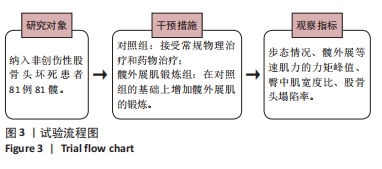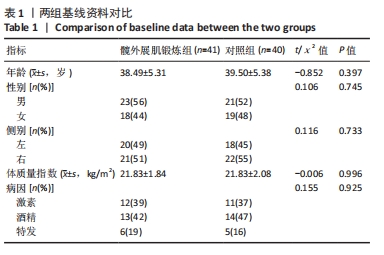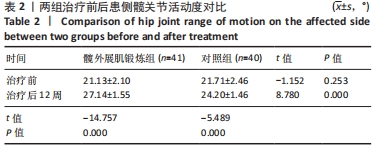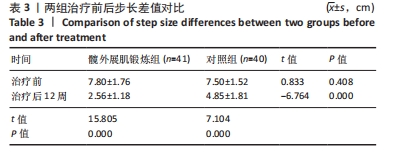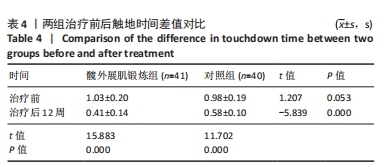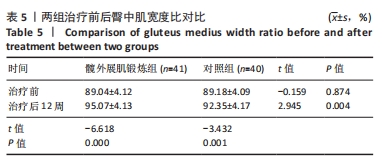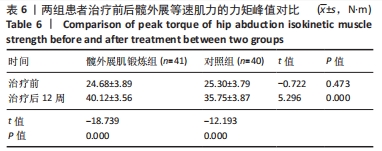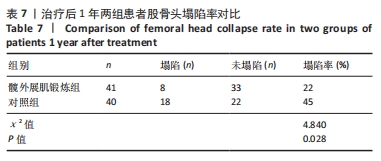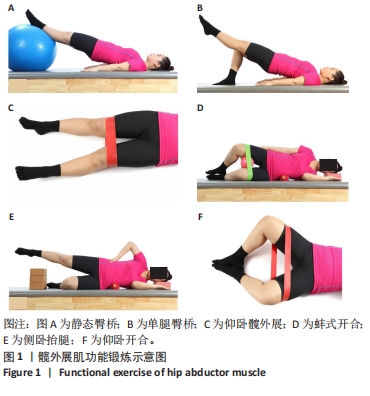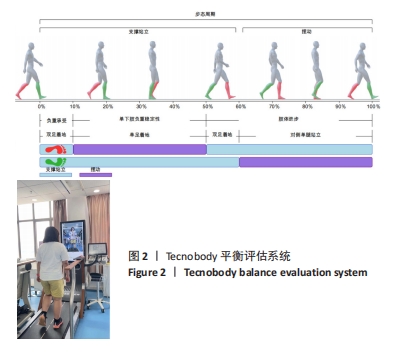中国组织工程研究 ›› 2025, Vol. 29 ›› Issue (33): 7211-7216.doi: 10.12307/2025.164
• 骨科植入物相关临床实践 Clinical practice of orthopedic implant • 上一篇 下一篇
髋外展肌锻炼对非创伤性股骨头坏死患者三维步态及塌陷率的影响
袁颖嘉1,2,易艳梓1,3,李 津1,2,王 珂1,2,王 煜1,2,林天烨1,2,张庆文1,2,何 伟1,2,魏秋实1,2
- 1广州中医药大学第三附属医院,广东省广州市 510405;2广东省中医骨伤研究院,广东省广州市 510405;3广州中医药大学第三临床医学院,广东省广州市 510080
Effect of hip abductor muscle exercise on three-dimensional gait and collapse rate in patients with non-traumatic femoral head necrosis
Yuan Yingjia1, 2, Yi Yanzi1, 3, Li Jin1, 2, Wang Ke1, 2, Wang Yu1, 2, Lin Tianye1, 2, Zhang Qingwen1, 2, He Wei1, 2, Wei Qiushi1, 2
- 1Third Affiliated Hospital of Guangzhou University of Chinese Medicine, Guangzhou 510405, Guangdong Province, China; 2Guangdong Provincial Institute of Traditional Chinese Medicine Osteopathy, Guangzhou 510405, Guangdong Province, China; 3Third Clinical Medical College of Guangzhou University of Chinese Medicine, Guangzhou 510080, Guangdong Province, China
摘要:
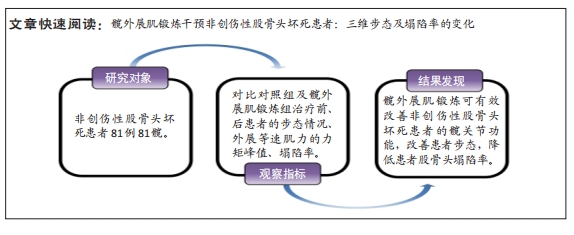
文题释义:
髋外展肌:主要是由阔筋膜张肌和臀中肌、臀小肌组成,这些肌肉不仅可以外展髋关节,也能在负重运动中起到稳定作用。髋外展肌群的紧张既会造成骨盆平衡失调,引起髋部疼痛,而且也会出现腰痛和膝关节痛。髋关节外展肌肌力训练适用于股骨头坏死患者,加强肌肉锻炼,延缓股骨头塌陷、预防跛行。三维步态分析:是指运用动作捕捉镜头、测力台、表面肌电图等设备同步采集患者在步行过程中的肢体运动参数。与影像学检查监测静态状态下骨骼、肌肉等的结构形态关系相比,三维步态分析的优势是可以观察人体运动过程中的关节、骨骼、肌肉协调运动情况,通过量化数据客观评估人体的整体运动功能水平,结合影像资料及临床物理评估,可为医生及患者提供客观精确的临床诊疗依据。
背景:非创伤性股骨头坏死是一个疑难的关节疾病,保留自身的股骨头对于年轻的患者而言意义重大,目前尚缺乏规律、统一的保髋功能锻炼方案。
目的:观察髋外展肌锻炼对非创伤性股骨头坏死患者三维步态及塌陷率的影响,为非创伤性股骨头坏死患者有效康复提供理论依据。方法:纳入2020年6月至2022年6月广州中医药大学第三附属医院收治的非创伤性、非手术性股骨头坏死患者81例81髋,随机将患者分为对照组(n=40)及髋外展肌锻炼组(n=41)。对照组接受常规物理治疗和药物治疗;髋外展肌锻炼组在对照组的基础上进行髋外展肌锻炼。治疗前及治疗后12周,采用Tecnobody平衡评估系统评估两组患者的步态情况(髋关节活动度、步长差值、触地时间差值);采用BIODEX-S4等速肌力测试系统测试髋外展等速肌力的力矩峰值;对比臀中肌宽度比。治疗后1年对比两组患者股骨头塌陷率的情况。
结果与结论:①两组患者在年龄、性别、侧别、体质量指数、病因等方面相比差异均无显著性意义(P > 0.05);②治疗前,两组患侧髋关节活动度对比无显著性差异(P > 0.05);治疗后12周两组患者患侧髋关节活动度均较治疗前改善(P < 0.05),且髋外展肌锻炼组患侧髋关节活动度显著大于对照组(P < 0.05);③治疗前,两组患者步长差值、触地时间差值对比无显著性差异(P > 0.05);治疗后12周两组步长差值、触地时间差值均较治疗前减小(P < 0.05),且治疗后髋外展肌锻炼组步长差值、触地时间差值显著小于对照组(P < 0.05);④治疗前,两组患者臀中肌宽度比对比无显著性差异(P > 0.05);治疗后12周两组臀中肌宽度比均较治疗前增大(P < 0.05),且治疗后髋外展肌锻炼组臀中肌宽度比显著大于对照组(P < 0.05);⑤治疗后1年两组患者股骨头塌陷率对比差异有显著性意义(P < 0.05),髋外展肌锻炼组(22%)显著小于对照组(45%);⑥提示髋外展肌锻炼可有效改善非创伤性股骨头坏死患者的髋关节功能,改善步态,降低患者股骨头塌陷率,建议将髋外展肌锻炼作为非创伤性股骨头坏死保髋基础方法之一。
https://orcid.org/0009-0005-5242-4635 (袁颖嘉)
中国组织工程研究杂志出版内容重点:人工关节;骨植入物;脊柱;骨折;内固定;数字化骨科;组织工程
中图分类号:
